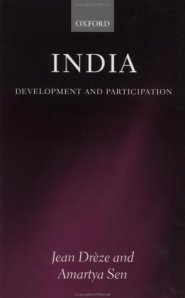Book review: India Development and Participation by Amartya Sen and Jean Dreze
Posted by Gokul
The amazing growth story of India in the new millennium and the countless problems that we face have spawned a cottage industry of books about the opportunities and the challenges faced by the nation. It has become very difficult to get the right book that identifies the challenges in the right perspective and suggests constructive solutions.
One way to choose is by looking at the profile of the author(s). Hence the work by the renowned economists Jean Dreze and Amartya Sen, who also have a good field experience in India was an obvious choice when I came across it in a book fair. The book India: Development and Participation is one of the most comprehensive work on the challenges faced by the nation in the socio-economic front.
Citing statistics and making comparisons with other parts of the world, it talks about the challenges in education, healthcare, women emancipation, liberalisation and decentralisation. The authors expose the myth of the inclusiveness of our growth story by showing that we lag behind sub-Saharan Africa in most of the health and nutritional indicators. The inter-state disparities is also brought into picture. Each chapter ends with a case study of the state in India that has been able to make definite progress on the subject when compared to the other states. A comparison with China, which has similar problems like us also help us in putting things in perspective.
Even as they applaud China for its success in the socio-economic front, the authors are unambiguous in their disapproval for the authoritarian methods used by then to achieve the ends. By noting the achievements of Kerala which has better indicators than China, they call for local, community based approaches to the major issues.
The chapter on women emancipation talks about an issue that is conspicuous by its absence in other similar discourses: the problem posed by widowhood and prospective widowhood that leads to choices like male-child preference. As the life expectancy of females are higher than males and because of our patriarchal norm of large age gap between the wife and the husband, this is a very serious issue in India.
The current edition was published in 2001. Hence the statistics are old. Interested ones can dig up the latest statistics from the original source that is given under every table. Also having written in 2001, it doesn’t talk about Naxalism which has become a serious problem off late. Being a result of the socio-economic and governance problems in the rural hinterland, an additional chapter on Naxalism can be added in future editions.
Hence as a whole, this book is one of the best written books on the socio-economic challenges faced by India. Written by eminent authors with good field experience, backed by authentic statistics and put in the right perspective, the book is a must read not only for people interested in public service but for every Indian so that we are not blinded by the glitz of our ‘growth’ story and lose sight of the humongous challenges we face.
Posted on April 20, 2011, in Books, from my life, india, just my thoughts, Political, Social and tagged Amartya Sen, China, Development, Education, Growth story, Healthcare, India, Jean dreze, Kerala, Naxalism, Participation, Socio-economic. Bookmark the permalink. Leave a comment.


Leave a comment
Comments 0